Genomic imbalance of HMMR/RHAMM regulates the sensitivity and response of malignant peripheral nerve sheath tumour cells to aurora kinase inhibition
- PMID: 23328114
- PMCID: PMC3702209
- DOI: 10.18632/oncotarget.793
Genomic imbalance of HMMR/RHAMM regulates the sensitivity and response of malignant peripheral nerve sheath tumour cells to aurora kinase inhibition
Abstract
Malignant peripheral nerve sheath tumours (MPNST) are rare, hereditary cancers associated with neurofibromatosis type I. MPNSTs lack effective treatment options as they often resist chemotherapies and have high rates of disease recurrence. Aurora kinase A (AURKA) is an emerging target in cancer and an aurora kinase inhibitor (AKI), termed MLN8237, shows promise against MPNST cell lines in vitro and in vivo. Here, we test MLN8237 against two primary human MPNST grown in vivo as xenotransplants and find that treatment results in tumour cells exiting the cell cycle and undergoing endoreduplication, which cumulates in stabilized disease. Targeted therapies can often fail in the clinic due to insufficient knowledge about factors that determine tumour susceptibilities, so we turned to three MPNST cell-lines to further study and modulate the cellular responses to AKI. We find that the sensitivity of cell-lines with amplification of AURKA depends upon the activity of the kinase, which correlates with the expression of the regulatory gene products TPX2 and HMMR/RHAMM. Silencing of HMMR/RHAMM, but not TPX2, augments AURKA activity and sensitizes MPNST cells to AKI. Furthermore, we find that AURKA activity is critical to the propagation and self-renewal of sphere-enriched MPNST cancer stem-like cells. AKI treatment significantly reduces the formation of spheroids, attenuates the self-renewal of spheroid forming cells, and promotes their differentiation. Moreover, silencing of HMMR/RHAMM is sufficient to endow MPNST cells with an ability to form and maintain sphere culture. Collectively, our data indicate that AURKA is a rationale therapeutic target for MPNST and tumour cell responses to AKI, which include differentiation, are modulated by the abundance of HMMR/RHAMM.
Figures
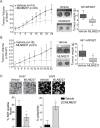
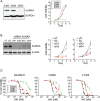

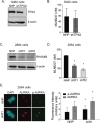
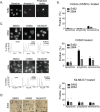
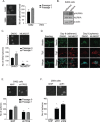
Similar articles
-
Spatial regulation of Aurora A activity during mitotic spindle assembly requires RHAMM to correctly localize TPX2.Cell Cycle. 2014;13(14):2248-61. doi: 10.4161/cc.29270. Epub 2014 May 29. Cell Cycle. 2014. PMID: 24875404 Free PMC article.
-
Hyaluronan Mediated Motility Receptor (HMMR) Encodes an Evolutionarily Conserved Homeostasis, Mitosis, and Meiosis Regulator Rather than a Hyaluronan Receptor.Cells. 2020 Mar 28;9(4):819. doi: 10.3390/cells9040819. Cells. 2020. PMID: 32231069 Free PMC article. Review.
-
Ras-driven transcriptome analysis identifies aurora kinase A as a potential malignant peripheral nerve sheath tumor therapeutic target.Clin Cancer Res. 2012 Sep 15;18(18):5020-30. doi: 10.1158/1078-0432.CCR-12-1072. Epub 2012 Jul 18. Clin Cancer Res. 2012. PMID: 22811580 Free PMC article.
-
The aurora kinase A inhibitor MLN8237 enhances cisplatin-induced cell death in esophageal adenocarcinoma cells.Mol Cancer Ther. 2012 Mar;11(3):763-74. doi: 10.1158/1535-7163.MCT-11-0623. Epub 2012 Feb 1. Mol Cancer Ther. 2012. PMID: 22302096 Free PMC article.
-
Role of receptor for hyaluronan-mediated motility (RHAMM) in human head and neck cancers.J Cancer Res Clin Oncol. 2014 Oct;140(10):1629-40. doi: 10.1007/s00432-014-1653-z. Epub 2014 Mar 28. J Cancer Res Clin Oncol. 2014. PMID: 24676428 Free PMC article. Review.
Cited by
-
Hyaluronan and RHAMM in wound repair and the "cancerization" of stromal tissues.Biomed Res Int. 2014;2014:103923. doi: 10.1155/2014/103923. Epub 2014 Aug 4. Biomed Res Int. 2014. PMID: 25157350 Free PMC article. Review.
-
Aurora A kinase inhibition enhances oncolytic herpes virotherapy through cytotoxic synergy and innate cellular immune modulation.Oncotarget. 2017 Mar 14;8(11):17412-17427. doi: 10.18632/oncotarget.14885. Oncotarget. 2017. PMID: 28147331 Free PMC article.
-
Spatial regulation of Aurora A activity during mitotic spindle assembly requires RHAMM to correctly localize TPX2.Cell Cycle. 2014;13(14):2248-61. doi: 10.4161/cc.29270. Epub 2014 May 29. Cell Cycle. 2014. PMID: 24875404 Free PMC article.
-
Hyaluronan Mediated Motility Receptor (HMMR) Encodes an Evolutionarily Conserved Homeostasis, Mitosis, and Meiosis Regulator Rather than a Hyaluronan Receptor.Cells. 2020 Mar 28;9(4):819. doi: 10.3390/cells9040819. Cells. 2020. PMID: 32231069 Free PMC article. Review.
-
Cell activity during peripheral nerve defect repair process using a nerve scaffold.Oncotarget. 2017 Dec 5;8(69):113828-113836. doi: 10.18632/oncotarget.22978. eCollection 2017 Dec 26. Oncotarget. 2017. PMID: 29371949 Free PMC article.
References
-
- Jett K, Friedman JM. Clinical and genetic aspects of neurofibromatosis 1. Genet Med. 2010;12(1):1–11. - PubMed
-
- Brems H, Beert E, de Ravel T, Legius E. Mechanisms in the pathogenesis of malignant tumours in neurofibromatosis type 1. Lancet Oncol. 2009;10(5):508–515. - PubMed
-
- Woodruff JM. Pathology of tumors of the peripheral nerve sheath in type 1 neurofibromatosis. Am J Med Genet. 1999;89(1):23–30. - PubMed
-
- Hagel C, Zils U, Peiper M, Kluwe L, Gotthard S, Friedrich RE, Zurakowski D, von Deimling A, Mautner VF. Histopathology and clinical outcome of NF1-associated vs. sporadic malignant peripheral nerve sheath tumors. J Neurooncol. 2007;82(2):187–192. - PubMed
Publication types
MeSH terms
Substances
LinkOut - more resources
Full Text Sources
Other Literature Sources
Research Materials
Miscellaneous

